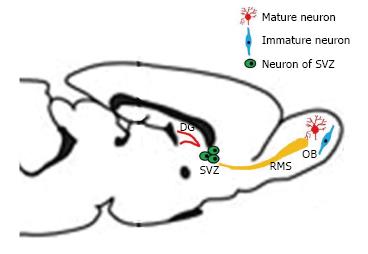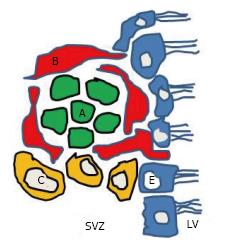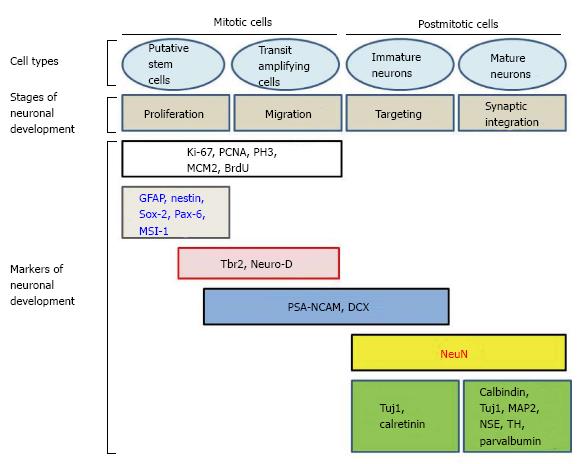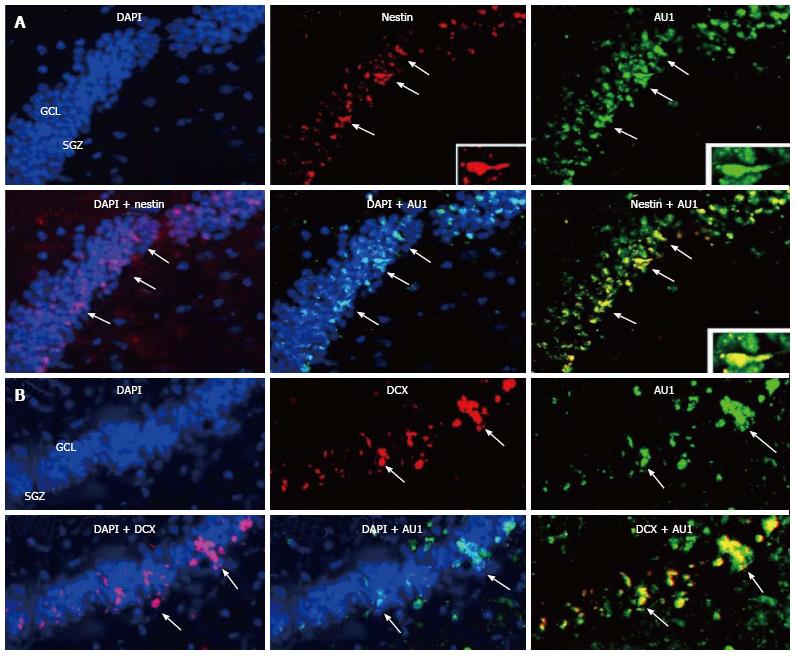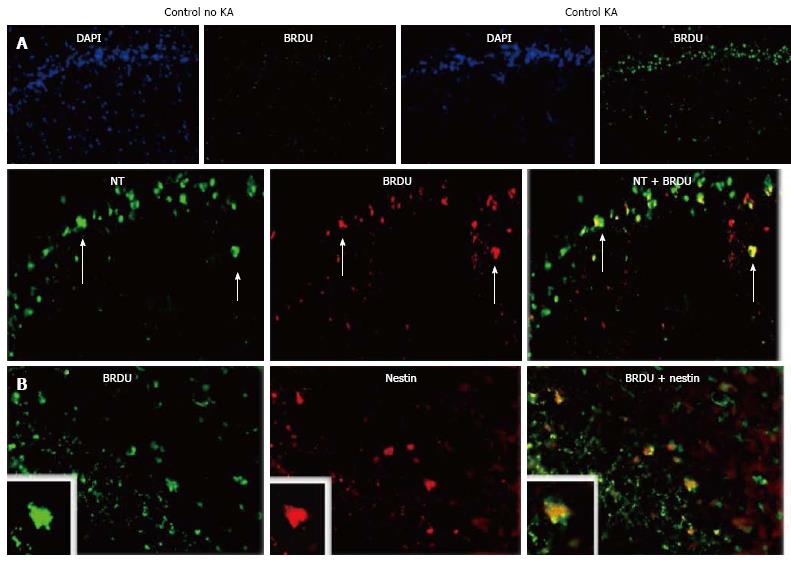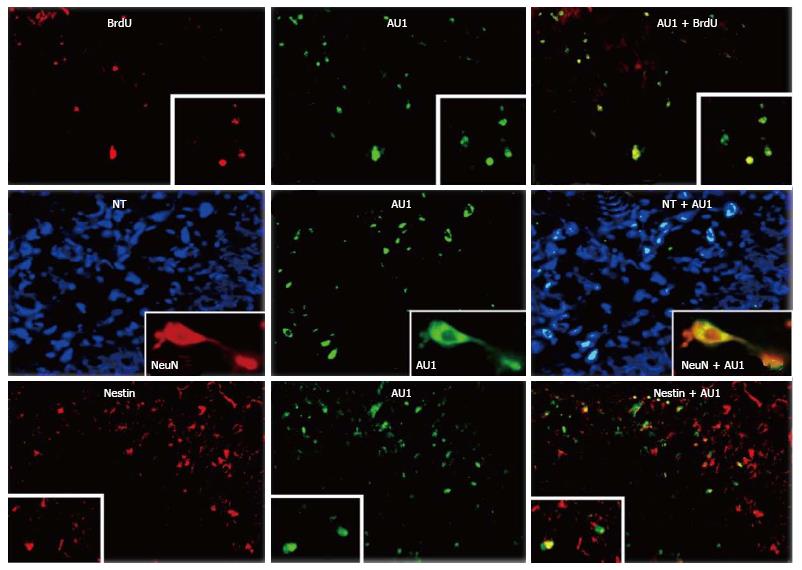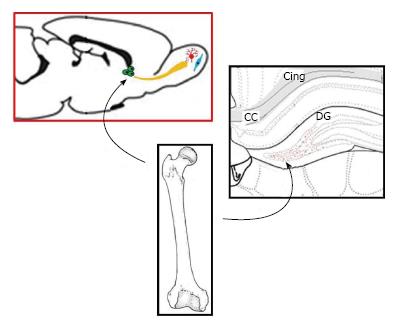Copyright
©The Author(s) 2016.
World J Stem Cells. Apr 26, 2016; 8(4): 136-157
Published online Apr 26, 2016. doi: 10.4252/wjsc.v8.i4.136
Published online Apr 26, 2016. doi: 10.4252/wjsc.v8.i4.136
Figure 1 Different areas of neurogenesis in the adult rodent.
The three areas of neurogenesis in the adult are the dentate gyrus of the hippocampus, the subventricular zone, and the olfactory bulb. Some progenitor cells are migrating from the SVZ to the OB, along a rostral migratory stream. DG: Dentate gyrus; SVZ: Subventricular zone; OB: Olfactory bulb; RMS: Rostral migratory stream.
Figure 2 Four different types of progenitor cells in the subventricular zone.
Type-A cells are migrating towards the olfactory bulb along the rostral migratory stream. Type B cells are believed to be the neural precursor cells and will give rise to both type C and type A cells. Type C cells are rapidly dividing immature precursor cells arranged in clusters along the migrating chains, and they are found only in the SVZ. E cells belong to ependymocytes lineage. LV: Lateral ventricle; SVZ: Subventricular zone.
Figure 3 Different markers of neuronal development in mitotic and postmitotic cells (modified from Ref.
[21,35]). PSA-NCAM: Polysialated form of the neural cell adhesion molecule; DCX: Doublecortin; GFAP: Glial fibrillary acidic protein; PCNA: Proliferating cell nuclear antigen; PH3: Phosphorylated form of histone 3; MCM2: Minichromosome maintenance protein 2; MSI-1: Musashi-1; MAP2: Microtubule-associated protein 2; NSE: Neuron specific enolase; TH: Tyrosine hydroxylase.
Figure 4 Bone marrow derived cells can migrate to the rat normal hippocampus.
Sixteen months after injection of SV (Nef-FLAG) into the rat bone marrow (BM), transgene expressing cells were detected in the dentate gyrus (DG). A: FLAG-positive cells colocalized with NeuN, a marker of mature neurons. FLAG+/NeuN+ cells were located in the granular cell layer (GCL), as well as in the subgranular zone (SGZ) and the hilus. No FLAG-expressing cells were detected in the brain after injection of SV (BUGT), a control vector, in the BM; B: Nestin+/FLAG+ cells were detected mainly at the border SGZ/GCL, and more rarely in the GCL (arrows); C: DCX+ positive cells expressing FLAG were seen at the border SGZ/GCL and more rarely in the GCL (arrows). Note that some FLAG+ cells were DCX-, and were probably mature neurons (arrowheads). In all experiments, nuclei were stained in blue by Vectashield containing DAPI.
Figure 5 Transgene (AU1) expression in the hippocampus of rats whose bone marrow has been injected with SV (RevM10.
AU1). A: Almost all DCX-positive cells were expressing AU1 (arrows); B: DCX+/AU1+ cells were of neuronal lineage, because they were stained by NT (arrows). No AU1 expression was seen after bone marrow injection of SV (BUGT), a control vector. DCX: Doublecortin; NT: Neurotrace.
Figure 6 Migration of bone marrow derived cells to the rabbit hippocampus.
Sixteen months after injection of SV (RevM10.AU1) into the rabbit bone marrow (BM), transgene-positive cells were seen in the dentate gyrus. Numerous AU1-positive cells colocalized with NeuN, a marker of postmitotic neurons (not shown). A: Nestin+/AU1+ cells were seen mainly at the border SGZ/GCL, and more rarely in the GCL (arrows); B: DCX+ positive cells expressing AU1 were detected at the border SGZ/GCL and more rarely in the GCL (arrows). SGZ: Subgranular zone; GCL: Granular cell layer; DCX: Doublecortin.
Figure 7 Kainic acid-induced regeneration in the hippocampus.
Rats were injected with kainic acid (KA) intraperitoneally (i.p.), 10 mg/kg, and their hippocampi (HCs) analyzed by immunomicroscopy 7 d thereafter. A: Neurogenesis following KA treatment. Rats given KA or saline were injected with BrdU. Then, at 7 d post-KA, their DGs were immunostained for BrdU to visualize proliferating cells. DAPI counterstain is shown to facilitate interpretation. Arrows show neurons positive for BrDU. Double staining with Neurotrace (NT) for neurons is shown below; B: Double staining for nestin, a marker of proliferating and migrating neural cells (modified from Ref. [132]).
Figure 8 RNAiR5 gene delivery to the bone marrow increases numbers of bone marrow-derived cells in the hippocampus and neuroproliferative activity in the hippocampus, in the resting state and in response to kainic acid treatment.
Bone marrow-derived cells in the hippocampus (HC) were all neurons, and most proliferating cells in the HC were bone marrow-derived. Double immunostaining for AU1 plus BrdU (upper row) and nestin (lower row), and neuron identification using Neurotrace (NT) and NeuN (middle row) was performed. Shown are HC sections from kainic acid-treated rats, transduced with SV (RNAiR5-RevM10.AU1). Most of the AU1+ cells were also positive for BrdU (79.8%, ± 6.9%) as a marker of cell proliferation, and most BrdU+ cells were also AU1+ (72.2%, ± 7.4%). Numerous AU1+ cells were also positive for nestin, a marker of proliferating and migrating neurons, although there were as well many nestin-positive cells that did not express AU1. The equivalence of NT identification of neurons and NeuN immunostaining of neurons is illustrated in the insets in the middle row. Data are representative of 3 independent experiments (modified from Ref. [132]).
Figure 9 Figure suggesting the participation of bone marrow progenitor cells to neurogenesis in adults.
DG: Dentate gyrus.
- Citation: Dennie D, Louboutin JP, Strayer DS. Migration of bone marrow progenitor cells in the adult brain of rats and rabbits. World J Stem Cells 2016; 8(4): 136-157
- URL: https://www.wjgnet.com/1948-0210/full/v8/i4/136.htm
- DOI: https://dx.doi.org/10.4252/wjsc.v8.i4.136









